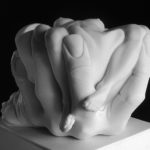How a Sculptor thinks Edward Fleming 4.7.22
Historically, the word Sculptor has referred to an artist or artisan who carved stone, as opposed to modeling clay or fabricating other media. From the perspective of architecture and design, this is an important distinction and is just as relevant today as it was a thousand years ago.
Creating a finished form from a solid block of marble requires removing exactly the right amount of stone and leaving the desired form. This may sound obvious and straightforward but it calls for an ability to visualize form, volume and composition to a level where the artist can remove stone with confidence and reveal the form as designed. This is the opposite or “inside-out” approach to most other media, such as metal or clay: once the material is removed, it can’t be replaced. Carving stone is a process of moving forward with no way back and this calls for an ability to visualize form at a much higher level than in everyday life.
Art and Architecture have a lot in common and the process of visualization is one of their fundamental, common aspects. Many tools have been developed over the centuries to help artists and architects visualize form and most recently, 3D computer graphics can do this at an incredibly detailed and accurate level. This is a tool I use in architectural design and also for presenting ideas to clients. But a machine or a program help illustrate and refine an idea, they do not create the idea.
The ability to visualize, to actually see a complex, three-dimensional form in my mind (behind my eyelids, so to speak) is something I’ve learned over the course of almost 30 years of carving stone. This gives me a great advantage in architectural design and allows me to get to both an artful and practical solution quickly. This is a skill I bring to the table that benefits any project. I encourage you to visit my sculpture site and better understand the level of complexity of my work and how that skill could apply to your project.




